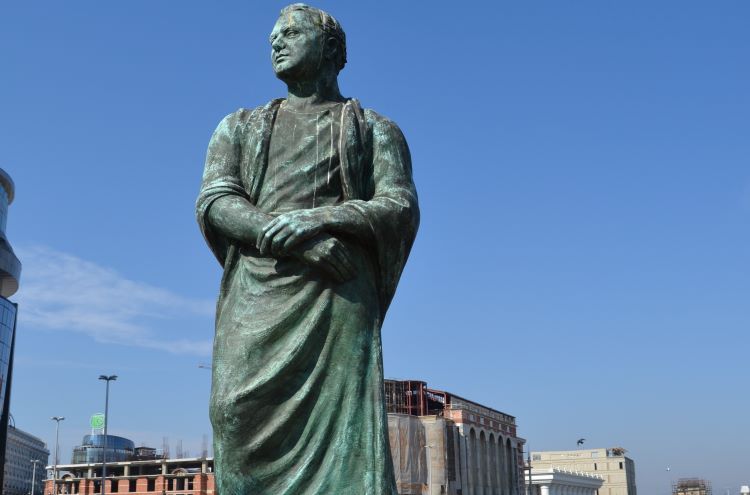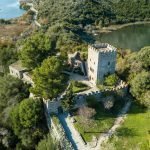
Kingdom of Paeonia: The Ancient State of North Macedonia
The kingdom of Paeonia was created sometime during the late V – early IV century B.C.E. It was inhabited by the Paeonians, an Indo-European/Illyrian population made up of several smaller tribes. Before creating their kingdom, as attested by sources, the Paeonian tribes occupied way larger territories than that held by the kingdom. However, due to pressures from the Persians, Thracians, and then the Macedonians, the Paeonian tribes moved constantly inland. By the time their kingdom appeared in literary sources, the territory of the Paeonian kingdom occupied much of current North Macedonia.

Against Philip
The first attested Paeonian king is Agis. We cannot be sure if he was the founder of the Paeonian kingdom. In fact, almost nothing is known about him except that his rule, whenever it began, lasted until 359/358 B.C.E. He was succeeded on the throne by Lykkeios (or Lykpeios; Lyppeios), likely his son. The succession occurred at a time when Philip II of Macedon had also ascended the Macedonian throne, eager to secure his borders. Thus, the Macedonian king used the transition on the Paeonian throne to make a campaign against the Paeonians. Thus Philip led an army trained in the phalanx formation and engaged the Paeonians in their lands, in the so-called battle of Paeonia. The Macedonians came up victorious marking the first victory for Philip’s phalanx. The Paeonians were forced to recognize an indirect Macedonian authority over their state.
In the summer of 356, Lykkeios joined the Illyrian king Grabos and that of Thrace Ketriporis, as well as Athens, into an alliance against Philip. The alliance had no effect in removing the Macedonian yoke over Paeonia as Philip acted quickly before the allies could join forces. Paeonia as a political entity under Macedonian hegemony appears in the First Olynthian of Demosthenes (349) and then in the “Philippos” of Isokrates (346). However, all considered, Paeonia maintained its independence though the Paeonians had to pay a yearly tribute to Macedon and likely serve in its army. Yet, Lykkeios became the first Paeonian king to issue his own coins; a further testimony of Paeonian preservation of independence. He continued to issue his silver coins throughout his entire reign. The late years of his reign that lasted until 340-335 were peaceful and prosperous.
Patraus
Patraus’ successor of Lykkeios ruled Paeonia in a period of high international intensity; his reign covered both Alexander the Great’s epic expedition and the Wars of Succession between his generals. Yet, we know nothing more about Patraus except the fact that he too, like his predecessor, struck silver coins. It’s unfortunate we know nothing else about Patraus, especially considering the Paeonian military contribution in Alexander’s campaign in Asia. The service into the army of the Macedonian king derived from Philip’s establishment of Macedonian influence of Paeonia. Thus, Paeonia had to provide a certain number of troops on Macedonian request in exchange for preserving their independence. As a kingdom, it was the Paeonian king’s duty to levy such a force. Thus, it was Patraus who levied the Paeonian units that swept Asia with Alexander, and still, we hear nothing about it.

Literal sources tell us more about the Paeonian contingents of Alexander after they had already joined him. Initially, the Paeonian that crossed the Hellespont with Alexander were 150 men in a single unit (one ilai). Then, some 500 other Paeonians joined the expedition in Egypt (332); next, an additional six hundred Paeonian soldiers reinforced Alexander’s army at Susa (331). All of these contingents consisted of cavalrymen armed with both missile weapons and sidearms. Paeonians were indeed very good riders for the time; they did carry a shield but did not wear a breastplate. All Paeonians were led by their own general, one Ariston (likely a brother of Patraus) who distinguished himself at Gaugamela (331). At the decisive battle of Issus, we find them incorporated under a larger contingent commanded by Antiochus (father of Seleucus). After the victory over Persia, Paeonians garrisoned the conquered cities, and Ariston, the member of the royal family, likely stayed there.
Audoleon
By 310, Audoleon, likely son of Patraus, had already ascended the throne of Paeonia. In that year, he was threatened by the Illyrian tribe of the Autariatae. The intervention of Cassander saved Audoleon from danger. This means that Audoleon was on friendly terms with the Macedonian ruler. As to the Autariatae, Cassander dealt with them by resettling about twenty thousand of them beside Mount Orbelos. The ties with Cassander provided Audoleon with knowledge on the way the Successors of Alexander established their own states. By 306, these Successors all began proclaiming themselves as kings in their own rights, founding new dynasties in their respective territories. After 306, Audoleon, copying the Successors, issued coins that proclaimed him as king of Paeonia. In doing so, he declared to all that he was king of Paeonia, a fully independent state free from any obligation towards Macedon.

Audoleon is the most renowned of the Paeonian kings. During his rule, the kingdom of Paeonia reached the highest level of prosperity. After 301, the ambitious Demetrius I Poliorcetes disposed of the heirs of Cassander from Macedon and established his own dynasty. Pyrrhus of Epirus sought regional allies to check Demetrius’ ambitions and one of these allies was Audoleon; the Epirote sealed the alliance by marrying a daughter of Audoleon.
Ally of Athens
The alliance proved effective both for Pyrrhus and Audoleon; in 287/286, Pyrrhus, Lysimachus, Ptolemy, and their allies attacked Macedon and Greece simultaneously from different directions forcing Demetrius out. In the aftermath, Macedon was divided between Pyrrhus and Lysimachus but Athens had its port blocked by Antigonus Gonatas, Demetrius’ son. Thus, famine struck the mighty city who sought help from the allies. Among those who helped the Athenians was Audoleon himself. In the early summer of 285/284, Audoleon delivered in Athens an aid of 6,500 medimnoi of grain (336.9 tonnes). The relief of the Paeonian king, taken care of at his own expense, is a further testimony of the Paeonian wealth at the time.

Intervention of Lysimachus & Instability
After Audoleon’s demise in 284-282, a conflict for succession rose. This allowed for the intervention of outside forces, namely that of Lysimachus. According to Polyaenus, “Lysimachus took measures to restore Ariston, son of Audoleon, to Paeonia, in order that the Paeonians, recognizing their heir apparent, might receive Lysimachus himself in a friendly spirit. But when they [the Paeonians] proceeded to give Ariston the royal baptism in the river Astibos and set the royal table before him according to the tradition of their tribe, Lysimachus sounded the call to arms. Ariston fled to Dardania, and Lysimachus got possession of Paeonia’‘ (Pol. IV. XII.).
Lysimachus’ annexation of Paeonia was short-lived; in 281 he was killed in battle against Seleucus. Another power vacuum threw Paeonia once again into instability. To make things worse, in 280/279 a large Gallic/Celtic invasion swept Paeonia. These Gauls, coming from the middle Danube plain, moved as far as Delphi, ravaging and pillaging everything on their way. They were defeated and disbanded only in 277 by the king of Macedon, Antigonus II Gonatas.
The ravaging of Paeonia from the Gauls tanked the Paeonian economy. Apart from the immediate destruction of property, the country suffered from a serious manpower shortage as well. In the coming years, the kingdom would never reach the glory it once had under Lykkeios and Audoleon. The silver disappears from Paeonian coinage; the last two kings of Paeonia, Leon (r. 278/277-250) and Dropion (r. 250-230) only produced modest, bronze coins.
Leon
As for the next king to assume the throne, we know nothing of the Ariston who fled to Dardania. Rather, Leon, likely another son of Audoleon, took over the kingdom after 278 taking the burden of recovering it with him. Even though he inherited an impoverished state, Leon made the most of his few resources. He eventually revived the monetary policy of Paeonia, though, as we mentioned, through bronze and not silver. Leon made sure that his coins bore the inscription of “basileus” (king), continuing the tradition established by Audoleon. All this shows that Leon was a pragmatic and competent ruler.
Dropion
Dropion, the successor of Leon, took further the economic and political recovery of Paeonia. It’s ironic that he was the last king of Paeonia because he likely was a powerful king. Notably, Dropion pledged gifts and raised monuments in the large sanctuaries of Delphi and Olympia. He also founded the Paeonian League (koinon), in an effort to modernize the constitution of his state. This league constructed an equestrian statue in his honor at Olympia crediting him as its founder and king. This honor shows that Dropion intended the League as a parallel institution to the kingship but still subordinate to the king.
Dropion’s foreign policy was anti-Macedonian. He allied himself with the enemies of Macedon, Aetolia, and Achaea. Dropion thus supported these states in their war against the Macedonian king Demetrius II (r. 239-229). The last years of Dropion’s reign are obscure; there are no records of a successor of Dropion. With Dropion ends the line of Paeonian kings that started with Agis. We do not know the political status (monarchy, republic, or hybrid) of Paeonia in the following years. Whatever the status, Paeonia became too weak to resist outside interventions.
The Fall of Paeonian Kingdom
The Macedonian king, Antigonus II Doson (r. 229-221), took his arms against Paeonia and ended its independence. He founded a new city along with the newly conquered territory, named Antigoneia no doubt after himself. While Antigoneia maintained Macedonian authority in this area, northern Paeonia likely fell under Dardanian authority. Only a small portion of the Paeonian kingdom, centered around Bylazora, kept its independence for another decade. In 217, this last stronghold of the Paeonian state was captured by Philip V of Macedon. The fall of Bylazora completed the annexation of Paeonia into the Macedonian kingdom. The new Macedonian province (strategia) of Paeonia was ruled by the Paeonian royal officer Didas. He had his headquarters in Antigoneia which also served as the capital of the Paeonian province.
The Roman conquest of Macedonia in 168 marks the final disappearance of Paeonia from history. Macedon itself was divided into four administrative units. Paeonia broke up too; the portion west of the Axius fell into the Third Macedonian region while that east of that river into the Second Macedonian region. Two decades later it remained, as a whole, part of the new Roman province of Macedonia. However, by now, Paeonia had vanished as a political and ethnic concept, with only some meaning as a geographical reference.
Bibliography
IGII31 871. Citizenship for king Audoleon. Source: https://www.atticinscriptions.com/inscription/IGII31/871.
Merker, I. L. (1964). The Ancient Kingdom of Paionia. Rutgers, The State University.
Pavlovska, E. The Coinage of the Paeonian kings Leon and Dropion.
Pavlovska, E. (2012). A Coin Hoard of the Paeonian king Lycceius. Skopje.









Are you serious with Indo-European/Illyrian term? Please tell me what does Illyrians have similar with Albanians?
This questions is a little bit strange coming from someone who is named “Ilir”. The ethnic link connecting Illyrians to the modern Albanians is the language element. How do we know that? The quickest response is based on a deduction, meaning a reasoning following a process of elimination thought. By this process, the only successor to the Illyrian language is the Albanian language as no other language fits the role and, at the same time, no other ancient language, despite the Illyrian, precedes the Albanian language. So the scientific explanation tells you that Illyrians and the Albanians have similar the language that they speak; the words that you utter in Albanian. This does not exclude outside influences in a century-old language. But the core is there and it cannot be denied.